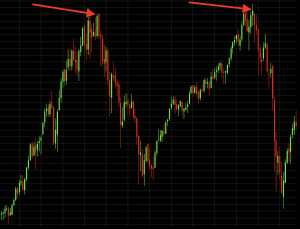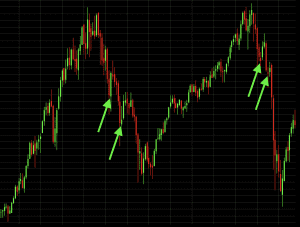Day Trading in a Bear Market

Day trading in a bear market can be a grand opportunity given how so much more volatility is present in nearly all asset classes. Generally speaking, outside of certain options strategies, or for long-term investors who primarily rely on coupon and dividend payments, markets need to move to some extent in order for traders to make money.
The Top Brokers For Bear Market Trading
Generally speaking, there are a few basic strategies for day trading in a bear market. But first, it’s important to understand what a bear market is fundamentally caused by.
What’s a Bear Market?
A bear market is defined as a drop in an asset’s value of at least 20%. A 10% fall is often termed a “correction”. These standardized definitions are useful to follow otherwise they inevitably become overused.
What is a Bear Market Caused By?
Fundamentally, a bear market is usually caused by a contraction in private sector credit creation. This is typically brought on by an overtightening of monetary policy by the central bank. While the Federal Reserve and other central banks will try to match interest rates to the point where price pressures and output exist in harmonious equilibrium, they always end up getting this wrong and tighten too excessively. This provokes a recession.
In other words, rates are raised too high and borrowers’ debt servicing burdens increase beyond their ability to pay for them. This sets off a wave of defaults and restructurings.
Lenders, in turn, fearful that they won’t be paid back, start increasing their lending standards. However, this exacerbates the problem. Credit growth and consumer spending slow. And higher rates and the inability to refinance debt causes more debt problems to emerge. The curtailing of credit means less investment and spending, which means incomes will decrease and risk asset prices will decline.
Equity markets will tend to peak before the economy because financial markets are discounting mechanisms and inherently take into account the future.
In countries that have large amounts of debt denominated in their own currencies, recessions will tend to be deflationary. This means that safe assets, such as fixed-coupon government bonds will tend to increase in value because the real (i.e., inflation-adjusted) value of their future coupon payments increases. This augments the demand for them. So you will typically see stocks decline but safe assets increase.
In countries that possess large amounts of debt denominated in currencies different from their own, recessions will tend to be inflationary. This is because investors believe that their lending will be paid back with money of depreciated value. These are often triggered by a rise in the currency that these debts are denominated in. For example, in 2018, Turkey and Argentina’s credit problems were exposed by a rise in the US dollar because these countries had large amounts of debt denominated in them. Debt servicing became harder to fulfill because the currency weakened, effectively increasing the cost of the debt. Monetary policy is ineffective as any money growth ends up going into inflation-hedged assets and other currencies.
In day trading, because you are trading on such a small timeframe, it is often easy to lose track of the broader picture. But staying abreast of what’s going on is important. The long-term trend is, after all, the cumulative effect of what happens day by day.
If you are day trading equities during a bear market and follow a contrarian strategy where you buy low but keep getting stopped out of your positions, it’s important to understand that you’re fighting a trend that’s proceeding in a very logical and mechanical fashion.
Day trading in a bear market requires the right approach. Outside of the standard day trading techniques that are technically oriented and apply to markets that are up, down, or ranging, here are three basic approaches to day trading in a bear market:
1. Short Selling

Short selling (“shorting”) involves borrowing shares and buying them back at a later time to cover the position, either profiting off the spread from the stock decreasing in price or losing money due to the stock going up.
It is often overlooked by beginning traders that stocks can be sold short rather than simply bought. In cases where the market is bearish due to debt problems facing an economy, causing equity markets to generally fall by 25 percent to 80 percent depending on the severity, short selling can be a very profitable strategy.
Since short selling is a form of borrowing, there are higher costs involved relative to buying stocks. In cases of buying, there is merely the charge of commission. For short selling, there is commission plus annual interest expense. Companies with plenty of available shares outstanding will generally have cheap borrowing costs. For companies with low floats, the cost of borrowing can often be quite high due to restricted supply.
Note, however, that short selling stocks is generally more difficult than being long. Equity markets tend to go up over time assuming that a) productivity remains on an upward trajectory and b) fiscal and monetary policymakers understand how to use their policy levers well and have the authority to make these decisions.
On top of that, bear markets are more volatile than bull markets. Bear markets, which are generally, but not always, a consequence of a credit contraction, are a tumultuous time for financial markets. Risk management accordingly needs to be on point to account for the extra volatility.
Short selling is also riskier in the sense that your loss potential is unlimited. If you are long a stock, the most you can lose is your entire principal, or 100 percent. When short selling, you can lose more than 100 percent – that is, the stock can more than double in value – and cause you to owe additional money to your broker.
2. “Buy The Dip”

Buy the dip is a common trend in bull markets for those are fundamentally bullish on the direction of stocks.
More technically oriented traders, who use contrarian, mean reversion strategies will often try to take advantage of bear markets as markets fall outside their typical ranges. For example, indicators such as Bollinger Bands and Keltner Channels will tell traders when price is trading at level outside normal boundaries per the specifications of the indicator that are set by the trader.
Trend following is a well-known trading strategy because there are reasons behind why a market is moving in a sustained direction. Accordingly, buying pullbacks is a common day trading strategy. Even during the Great Depression, the US equity market at one point rallied by as much as 30% before resuming its downward trajectory.
This is also a viable way for traders to make money who may not feel comfortable short selling stocks due to the aforementioned risks.
However, always note that flouting a strong trend in either direction can be a bad idea. The general idea is to anticipate levels of the market where buying is likely to be located and getting out at points where the market may be likely to go against you. Typically, the buying of equities is looked at as a quick counter trade when day trading in a bear market.
3. Stay Out of the Market or Hold Cash
Half the battle is knowing when to stay out of the market. Many traders wipe out because they simply trade too much. Trading profitably is not an easy thing to do. Whenever you make a trade in the market, there is somebody else on the other side of that and there’s a reason as to why they’re making it. You should always assume that that party is sophisticated and is likely an institutional buyer or seller.
Trading should only be done when you have an edge in the market. You need to have patience and not trade out of the desire for action. That’s how money is inevitably lost.
Warren Buffett, though a buy-and-hold investor and not a day trader, quipped: “We continue to make more money when snoring than when active.” Obviously, day trading is a more active form of playing the financial markets, but his point is broadly applicable regardless of trading style. Being disciplined, patient, and letting the market come to your price points is going to be much more productive than overtrading and entering into suboptimal setups where you have no realistic edge. When you don’t have an edge, it is the equivalent to arbitrarily gambling and you are virtually guaranteed to lose money provided enough time.
Conclusion
Day trading in a bear market can be highly profitable with the right approach. You are more likely to be successful if you can identify on a fundamental level when a bear market is occurring. In developed markets in particular, bear markets happen in a very mechanical and logical way, when credit and money available to service debt and other non-discretionary payments items is insufficient, leading to a series of restructurings and liquidations. This causes risk asset prices to fall.
You can profit off these events by short selling stocks. For those who can’t short stocks (in which case you probably need a different broker), you can buy dips. Or you can play it safe and sit out market volatility by simply staying out of the market or going into cash.
“Holding cash”, in terms of its financial meaning, typically carries the implication of holding safe, short-term bonds. It does not literally mean holding paper money or keeping money in a type of bank account that collects little to no interest. What the yields are on these safe bonds depends on where you go in the world. In emerging and frontier markets, these often carry credit risk, and therefore don’t really qualify as “cash”. They are generally short-term (less than two years in duration) bonds offering safe yields in A-rated (or better) credit markets. US Treasuries, UK gilts, and German bunds are the most prominent.



